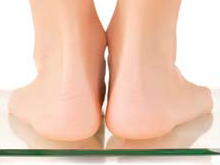Health Topics
-
Healthy Living
-
|
|
March 2010
|
| Flat Foot |
| Dr K J Reddy |
| |
 |
The foot is not meant to be completely flat, with all of it completely touching the ground. The arch in the foot is very important. There is a medical condition, in which this natural arch would have collapsed, making the feet very flat. Flat foot is a condition in which the longitudinal arch of the foot, which runs lengthwise along the sole of the foot, has not developed normally and is lowered or flattened out. |
Both feet could be affected, or just one. Flat foot could pass down in the family, or you could get it through injury or other medical conditions. What is essential is, to differentiate between the normal flat foot (which is not a problem), flat foot that stem from abnormalities in the nerves/joints/ ligaments or weakness in muscles of the feet.
Identifying the Cause
Those with flat foot won't become great sprinters or climbers, as their foot would have lost its natural spring action with the collapse of its arch. The strength in their foot for 'special activities' is lower tha in those feet having arches.
What you should try to find out while meeting your doctor, is to find out if a disease process has caused your flat foot. Your doctor would try to find out what has caused the flat feet in you. Abnormalities in the feet acquired from birth have to be first ruled out. Like say, in cases where a bone that is supposed to be horizontal is vertical – like in vertical talus. Or, it could be a problem in the spinal cord, where the muscles around it are paralysed. Or say, a child could have been born with normal feet, but got flat feet between 10 to 14 years of age (stemming from a condition called spastic flat feet). Polio, and tumours of the spine and the brain could also cause flat foot.
Ideal Footwear
Flat feet are like normal feet – they do not need any special appliances or braces – and they should not be operated on if they are painless. In fact, surgery could actually make some flat feet worse! What people with flat foot need is, mostly a comfortable shoe. Most people will feel comfortable with a little medial (arch side) support, but the support should not be overdone – that will make the feet uncomfortable, especially in children. Well fitting shoes tested by professionals are a must. You should be able to bend your toes inside your shoes: that is your correct shoe size. There should be a thumb size
Do you Have Flat Foot?
One easy way of finding out if you have flat foot, is to do the tiptoe test. On a flat floor, stand with your feet together. Do you see an arch along the sole? If you do, you have normal feet. But if you don’t, try tiptoeing: stand up on your toes. Does an arch form now? Your ligaments are tightened when you tiptoe – and thus an arch forms. If you get an arch now, you have flat foot.
space – not more, not less - between your big toe and the front of the shoe. These would be a proper fit for anybody, but more so for those with flat feet. Sandals, because of their back strap, would be a better choice than slippers, if you have to wear some. Trainers would suit flat feet better than hard leather ones.
Exercises
Most flat feet people are asymptomatic – without any symptoms. But occasionally, if they are overweight or have a weakness in their leg muscles, their feet would pain. Then, physiotherapy would help. One of the best exercises that you can do by yourself is to put warm water in a basin, and spread some glass marbles in it. Your objective is to try holding the marbles with your toes. Repeat as often as you feel comfortable.
A bit of support could also help release the pain. Though exercises are the major help, you may also need simple painkillers like Paracetamol occasionally.
All’s Well
Those with flat feet need a lot of reassurance. Once all the disease processes are excluded, there is nothing abnormal with having flat feet. Just that they should not try some activities like sprinting or climbing – these will cause pain. Other than that, they could get involved in all activities and games. The belief that those with flat feet will develop arthritis later in life is just a myth – there is no scientific basis for that. So if you are going in for a surgery because of normal (without disease processes involved) flat foot, you need to think many times about it. The surgery may convert painless flat foot to painful ones! |
 |
Dr. K J Reddy is Sr. Orthopaedic Consultant at Apollo Health City, Hyderabad |
|
|